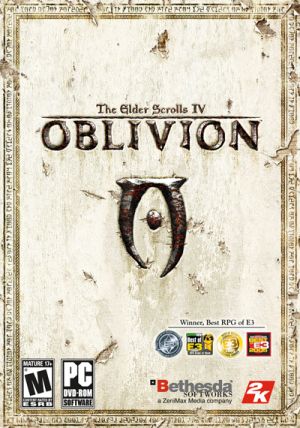The Elder Scrolls IV: Oblivion Review
-
Category: ReviewsHits: 14187

Article Index
Page 3 of 3
This leads me to think that Bethsoft made a strategic decision with Oblivion to grab a much younger playing audience which needs more hand-holding. It stands to reason: they have a captive market of older players from earlier titles, so they can concentrate on increasing revenues among pre-teens and early teens. I'll be the first to admit this is complete speculation on my part, but there's nothing speculative about the dumbing down of the ES series at this point. It looks beautiful, it has many of the thrills of yore, but it seems to be aiming not for the kid in me, but for the nine-year-old kid down the block who has to be told in advance precisely where the cave he's seeking in Cyrodil is, and what to do and how to do it when you're told to locate an artifact in it. Pardon my lack of enthusiasm. And talk about freebies! You couldn't grab an object from one of the Morrowind guilds for fear of being attacked on sight. Members were protective of their property, and rightly so. But rare and popular alchemy ingredients, weapons, soulgems, armor, books and scrolls are free and found in abundance at all the Oblivion guilds. It amounts to a Monty Haul giveaway that again would appeal to the child player. Bethsoft, if you're so anxious to close up loopholes that allowed players to have uber-spells and loot the occasional strong weapon in Morrowind, why create new exploits by giving newbie guild members full access to plenty of goodies?
If my theory of targeting a broadened market is correct, that might help to explain why there are far fewer books in Oblivion than in Morrowind, with all the stories and lore that helped add real background and detail to the place. (Kids, the theory goes, don't like to read. They only like their characters to kill and grab ever more powerful goodies.) The developers have, in a not very subtle fashion, chosen to compensate for the lack of books but putting multiple copies many times over on every shelf you can find. Even private houses seem for some strange reason to possess half a dozen copies of a few basic texts, and some of the guilds boast of nearly two dozen copies of a single title despite having only five or six members.
There are many other instances of changes that point to a more (youthful) clientele for Oblivion, but why bother?
The Core Game
There's still much to enjoy that was carried into Oblivion over from previous ES games, including a huge land, tons of quests that sometimes seem to appear spontaneously, lore-based artifacts whose purpose you must determine, and a mix of possible careers in thievery, magery, ranged and melee weaponry that actually work. Alchemy, too, remains a well-balanced and varied game system, and the overall structure of the title itself is of a unified design that claims my admiration. Despite the criticisms I have of Oblivion, it's easy to perceive a fine game under the surface, which accounts for its rating. What remains troubling is that the excellence in this title is arguably aimed now at a younger audience, much as Bioware's KotoR took a huge dive in intelligence from Baldur's Gate II. But would an Oblivion that didn't patronize its audience have done as well? I'm inclined to think so, especially with two platforms and all the advanced publicity Bethsoft used. I suppose, though, that at this point we'll never find out.


